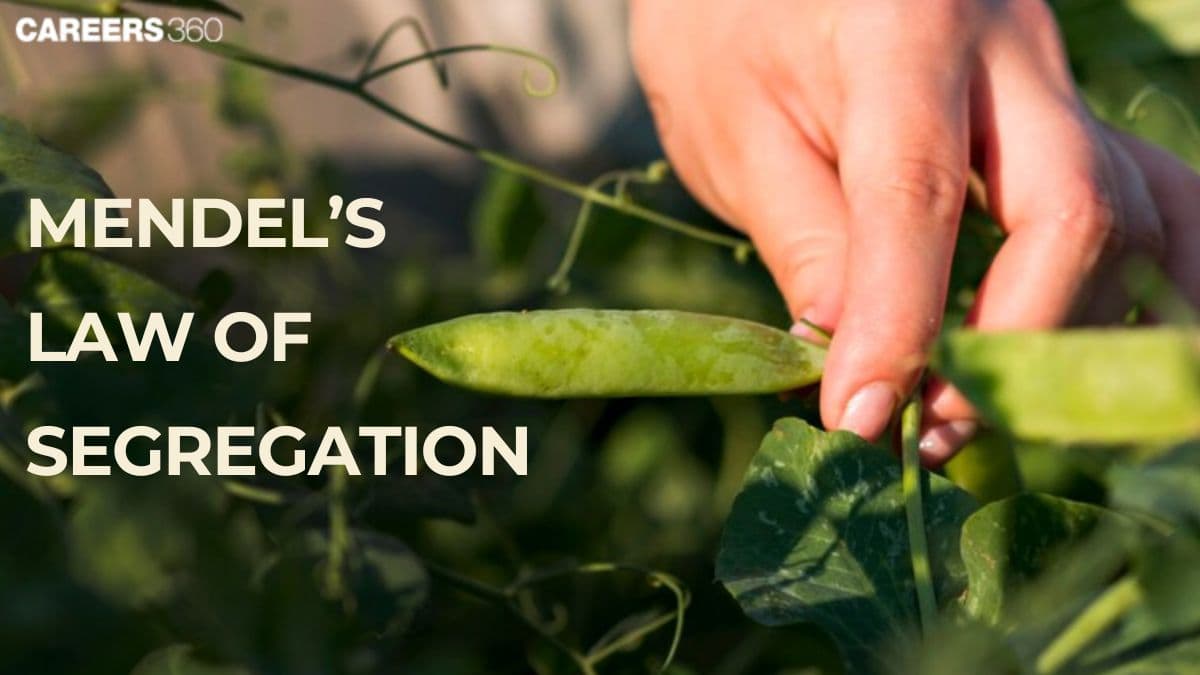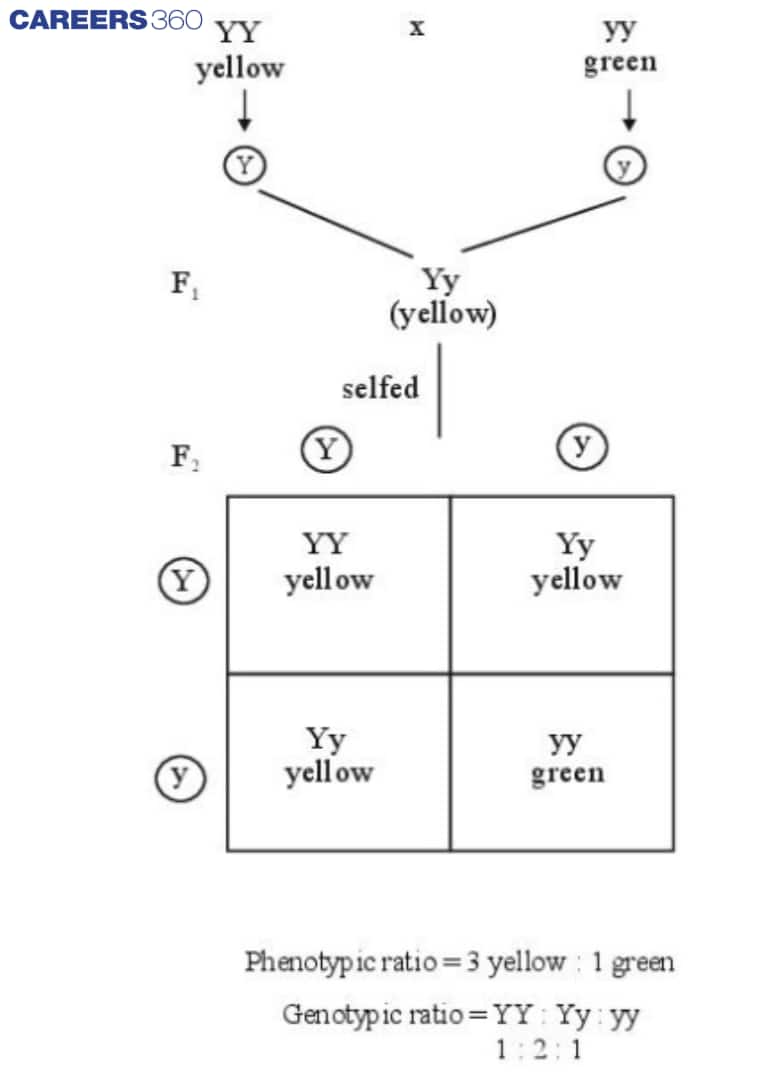Mendel's Law of Segregation: Definition, Examples, Segregation, Independent
Mendel proposed the law of segregation when he observed that the true-breeding plants with contrasting traits gave rise to F1 generations, who expressed the dominant and recessive traits in the ratio 3:1. The Law of segragation expresses that each individual having a pair of alleles for a particular trait, each parent passes an allele at random to their offspring, resulting in a diploid organism.
This Story also Contains
- What is the Law of Segregation?
- Mendel’s Experiments
- Mendel's Laws Of Inheritance
- Mendel’s Law of Segregation
- Observations and results
- Recommended video for "Law of Segregation"
- MCQs on Mendel’s Law of Segregation

The allele having the dominant trait determines the phenotype of the offspring. To quote, Mendel’s Law of Segregation states that “During the formation of gametes, each gene separates from each other so that each gamete carries only one allele for each gene”. Mendel’s Law of Segregation is an important topic in biology.
What is the Law of Segregation?
Gregor Mendel, the founder of modern genetics or, to be more precise, the person who discovered the laws of hereditary distribution, is worth mentioning. Early in the middle of the nineteenth century, he established the basic principles of how characteristics are inherited. He came up with Mendel’s Laws of Inheritance, which are: the Law of Dominance, Law of segregation, and the Law of Independent Assortment, which deals with the passing on of certain inherited genes.
These laws play a vital role in modern biology as they give a deep outlook on genetic variation and relation, heredity and the mechanisms of the transmission of traits. Mendel’s laws not only changed the approaches of the biological sciences but also played a significant role in medicine, agriculture, and other areas of evolutionary biology.
Mendel’s Experiments
The Austrian scientist and Augustinian monk, Gregor Mendel, made the groundbreaking discovery of the principles of inheritance through experiments carried out on pea plants in the mid-19th century. Gregor Anton Mendel was born in 1822 in the present-day Czech Republic he was also curious about the natural sciences and how characteristics are passed from one generation to another.
Mendel’s genetics studies were carried out by a process of selecting purebred pea plants, which are regarded as models because of their morphological characteristics that are features of genetic inheritance, and because they can be self-pollinated.
Major characteristics included plant height, the shape and colour of seeds, colour of flowers, pod shape and pod colour. Mendel was very rigorous in his work and followed the laws. He crossed the plants with different characteristics and documented the results carefully on successive generations. His creative statistical thinking helped him to come up with the Laws of Segregation and the Law of Independent Assortment, which paved the way for the foundation of genetics as a science.
Mendel's Laws Of Inheritance
Gregor Mendel brought great insight into the concepts of heredity through his studies of pea plants, and he was able to come up with three laws, which are vital in the study of heredity. These laws relate to patterns of inheritance from parent to offspring and are the foundation of classical genetics.
Introduction to Mendel’s Laws
The Law of Dominance expresses that in a heterozygous condition, an allele is dominant over another allele. Namely, the genotype of the organism will consist of the dominant allele’s trait, and the recessive allele’s trait will not be expressed phenotypically.
The Law of Independent Assortment states that the transmission of one character does not in any way affect the transmission of another character. This law works with genes that are on different chromosomes and/or distant from each other on the same chromosome, to require that alleles of different genes always get shuffled, independently of one another, during gamete production.
The Law of Segregation is among the major principles studied in Mendelian genetics. This law tells us that when the gametes are formed, the particular factors for that trait segregate or separate and end up in distinct gametes with just one factor of that trait. Inheritance is said to be done through alleles, which Mendel also noted that offspring get one allele of each trait from the respective parents. This segregation happens during the stages of meiosis, the type of cell division that results in the formation of gametes. The Law of Segregation explains the 3:1 phenotypic ratio that was discussed in Mendel’s monohybrid cross experiments and is a core to learning about inheritance.
Mendel’s Law of Segregation
The roles of the ABO blood group are explained by Gregor Mendel’s Law of Segregation. It states that the two alleles for a particular trait segregate from each other during the formation of gametes, thus each gamete will have one allele for the particular trait. This segregation makes sure that the children get one allele from each parent, hence balancing the alleles and making sure that alleles are recombinant in the next generations.
Significance of the Law
This law is important because it explains how variation is maintained within generations and how some traits can come back into play after having been previously missing for one or more generations. It established the basis for patterns of inheritance and variation systems, which are important to areas such as agronomy, pharmacogenomics, and evolutionary biology.
Mendel’s Monohybrid Cross Experiments
Mendel also performed experiments in which he crossed pure breeding pea plants that were heterozygous for one gene only for the characters like seed colour (yellow or green), flower colour (purple or white), etc. He was able to closely regulate the pollination of the plants for scientific purposes in arriving at the result.

Observations and results
In these experiments, Mendel found out the truth in the idea that dominant traits are hidden as a result of the presence of the dominant allele in the first generation of offspring, known as F1. When these F1 plants were allowed to self-pollinate, the second generation (F2) showed a phenotypic ratio of approximately 3:1.
Recommended video for "Law of Segregation"
MCQs on Mendel’s Law of Segregation
Q1. Which of the following relates with the law of segregation?
Option 1: Anaphase-1
Option 2: Telophase-1
Option 3: Prophase-1
Option 4: Pachytene
Correct answer: (1) Anaphase-1
Explanation:
The law of segregation accounts for the separation of two alleles of a gene that are present on the pair of homologous chromosomes. Since the separation of homologous chromosomes occurs during the anaphase-I of meiosis-1, as a result, it relates to the law of segregation. This ensures that each gamete receives only one allele from each pair, maintaining genetic variation in offspring. The process occurs during anaphase I of meiosis, where homologous chromosomes, along with their respective alleles, separate and move to opposite poles. This fundamental principle of Mendelian genetics explains how traits are inherited and why offspring exhibit different genetic combinations.
Hence, the correct answer is option (1) Anaphase-1
Q2. Directions: In the following questions, a statement of Assertion (A) is followed by a statement of reason (R).
Assertion: There is a 50 % chance of a gamete containing either allele.
Reason: Segregation of chromosomes or alleles is a random process.
Mark the correct choice as:
Option 1: If both assertion and reason are true, and the reason is the correct explanation of the assertion
Option 2: If both assertion and reason are true, but the reason is not the correct explanation of the assertion
Option 3: If the assertion is true but the reason is false
Option 4: If both assertion and reason are false
Correct answer: (1) If both assertion and reason are true and the reason is the correct explanation of the assertion.
Explanation:
Law of Segregation -This law is based on the fact that alleles do not show any blending and that both characters are recovered as such in the F2 generation. According to Mendel, the segregation of sister chromosomes is a random process. Alleles present on sister chromosomes would also separate in a random way.
Hence, the correct answer is Option (1) If both assertion and reason are true and the reason is the correct explanation of the assertion.
Q3. Assertion: In a monohybrid cross, the two alleles for a trait segregate during gamete formation.
Reason: Each parent contributes one allele to the offspring.
Option 1: Assertion and Reason are both true, and Reason is an accurate account of Assertion.
Option 2: Both Assertion and Reason are accurate, but Reason does not adequately explain Assertion.
Option 3: The assertion is correct, but the reasoning is incorrect.
Option 4: Both Assertion and Reason are incorrect.
Correct answer: (1) Assertion and Reason are both true, and Reason is an accurate account of Assertion.
Explanation:
The law of segregation states that during gamete formation, the two alleles for a trait separate, with each gamete receiving only one of the two alleles. This is supported by the reason that each parent contributes only one allele to their offspring. Therefore, the offspring inherit one allele from each parent, resulting in two alleles for the trait.
Hence, the correct answer is Option (1) Assertion and Reason are both true, and Reason is an accurate account of Assertion.
Also Read:
Frequently Asked Questions (FAQs)
Mendel’s Law of segregation holds that during the formation of gametes where two gametes are being formed, the two alleles for a particular gene are separated randomly in such a way that a given gamete is never a carrier of two alleles of one gene at the same time.
Genotype: The genotype means the genetic constitution of an organism which is the set of alleles possessed by him in connection with a particular character.
Phenotype: Phenotype is the actual manifestation of an organism in terms of its issues or features which are distinct from the genotype and/or depend on the genotype-environment interface.
Punnett Squares are a graphical representation that enables the identification of the genetic makeup of offspring about the likely genotypes and phenotypes attached to the parents’ alleles. They also show that alleles are separated and independently sorted in the formation of the gametes that are involved in the reproductive process and therefore explains Mendel’s Law of Segregation.
Since the segregation paper brings out the core understanding of how genes work, it is hugely significant in genetics that it unveils segregation as the process through which these traits are inherited from one generation to the next. It is used as a foundation for studying the patterns of inheritance, different populations, and the segregation of heritable diseases. This law is crucial for scientists and specialists in all branches of genetics and biology for selecting plants in agricultural reproduction, research in human genetics, and the study of evolutionary processes.